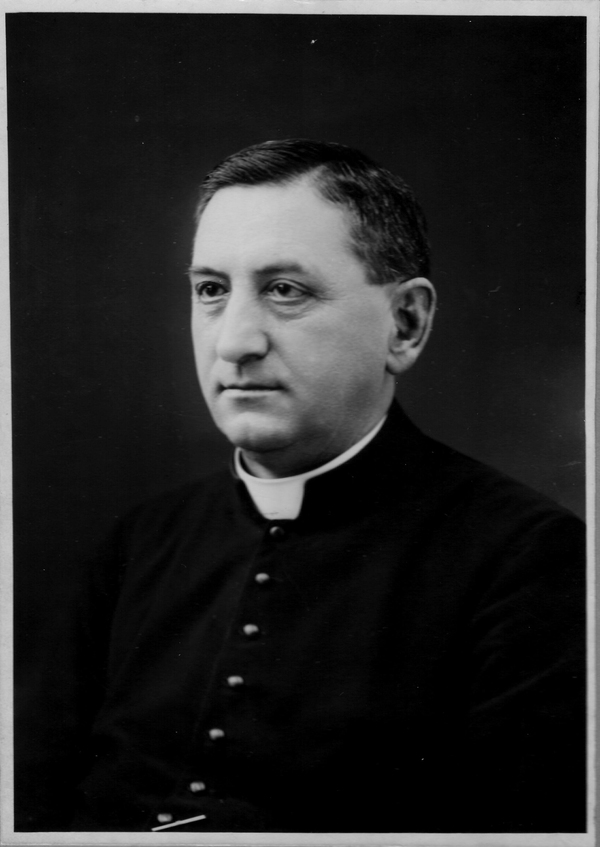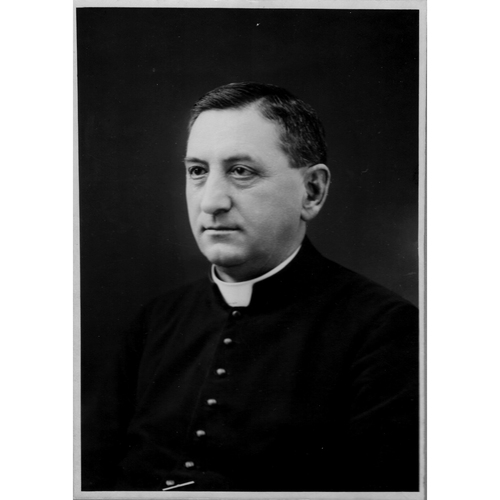
Source: Link
ROCH, JOSEPH-AVILA, Roman Catholic priest, teacher, and first superior of the Société des Missions Étrangères de la Province de Québec and of its seminary; b. 20 June 1875 in Saint-Norbert, Que., son of Clément Roch, a farmer, and Marie-Délia Laporte; d. 21 Dec. 1940 in Montreal.
Joseph-Avila Roch was the eldest son in a family of 12 children, 3 of whom would become priests and 2, nuns. Following his classical studies at the Collège Joliette (1889–97), where he distinguished himself through his oratorical gifts and leadership qualities, he entered the Grand Séminaire de Montréal in 1897. He returned to the Collège Joliette in 1899 as a teacher and monitor while continuing his theological studies. Ordained priest in Montreal on 1 June 1901 by the archbishop of Montreal, Paul Bruchési, he was appointed curate of the parish of Sainte-Geneviève-de-Berthier, which would become part of the diocese of Joliette, established in 1904. On the recommendation of the Sulpicians, who were in charge of the Grand Séminaire de Montréal, he was sent by Archbishop Bruchési to the College of the Sacred Congregation of Propaganda in Rome in October 1902. There he obtained two doctorates, one in theology in 1904 and one in canon law the following year.
In 1905 Roch returned to Canada and began teaching philosophy and theology at the Séminaire de Joliette, known until the previous year as the Collège Joliette. According to the accounts of his former students, he was well regarded as a teacher for his clear and methodical instruction. His clerical education and his upbringing had instilled in him not only respect for authority, but also familiarity with human relationships and a sense of obligation and loyalty, which moderated his rather impetuous nature. As a valued adviser to his bishop, Guillaume Forbes, Roch was appointed canon on 8 Dec. 1914. Of all the tasks he would undertake throughout his life, teaching would always be his favourite. It was owing to his sense of duty, therefore, that, in 1918, he answered the call from Bishop Forbes, who asked him to become the curé of the cathedral of Saint-Charles-Borromée in Joliette. In his parish he dedicated himself to a mission of reconciliation and spiritual renewal by holding closed retreats. Through his concern for the poor and the sick he soon became attached to his parishioners, but his presence in the cathedral would be of short duration.
Shortly after the end of World War I, faced with the disastrous state of the Catholic missions, which were suffering from a shortage of personnel and material resources, Pope Benedict XV called for a missionary renewal in his encyclical of 30 Nov. 1919. In response to this appeal, in which the creation of seminaries for missions was given priority, the French Canadian episcopate decided on a local initiative to increase the participation of the secular clergy in foreign missions. Rather than limiting their efforts to providing new recruits for missionary institutes of European origin, the bishops wanted to establish their own mission seminary. In pursuing this objective they were of one mind with Délia Tétreault*, the founder of the Missionary Sisters of the Immaculate Conception, who had been promoting a new mission seminary for several years.
On 2 Feb. 1921, therefore, the bishops of the province of Quebec decided to establish such a seminary and to set it up in the archdiocese of Montreal [see François-Xavier Brunet*]. They entrusted the implementation of the undertaking to an episcopal committee chaired by Paul-Eugène Roy*, coadjutor archbishop of Quebec; Bishop Forbes was the secretary. Dreaming of a return to teaching, Roch offered his services as professor of theology in the future seminary. On 12 May the bishops named him, instead, the first superior of their new institution, a role involving practical organizational work that held little appeal for Canon Roch. Although these new responsibilities disrupted his plans, he deferred once again to his sense of duty as well as to the conviction that he was serving a cause of utmost importance to the French Canadian church.
Under the authority of the episcopal committee, Canon Roch set to work, taking on two assistants, the abbés Louis-Adelmar Lapierre of Montreal and Clovis Rondeau of Joliette. By the autumn of 1921 the trio had moved into the former presbytery of the parish of Sainte-Madeleine, in Outremont (Montreal), which had been provided by the Clerics of St Viator. They devoted the winter to promoting the cause in the parishes and colleges of the province, fund-raising among the clergy, and searching for a piece of land on which to build the new seminary. The Société des Missions Étrangères de la Province de Québec was incorporated by provincial statute on 8 March 1922. The goals of this body, which had a board of directors consisting of four bishops, were to ensure, among other things, the training of the secular clergy as missionaries and the promotion of their participation in Catholic missions abroad, especially in the Far East. The seminary would therefore become the cornerstone of this initiative of the French Canadian episcopate.
Under the authority of the society’s board of directors, Roch proceeded, on 27 April 1922, to purchase a lot on the banks of the Rivière des Prairies at Saint-Vincent-de-Paul (Laval), in the region that would become the municipality of Pont-Viau (Laval) in 1926. The construction of the seminary, watched over by Roch and paid for by the day, lasted for more than a year. The canon and his colleagues took possession of the building on 27 Feb. 1924, and in September the new institution opened its doors to 7 priests and 15 seminarians.
In addition to his duties as superior, procurator, and teacher of Holy Scripture at the seminary, Roch took on the responsibility of organizing, for diocesan priests, the Société des Missions Étrangères, which the new missionaries would join. Thus, on 6 Jan. 1925 the coadjutor archbishop of Montreal, Georges Gauthier, canonically established the society, as well as its seminary, and approved their respective regulations for three years. On 1 June Canon Roch and 12 colleagues took the vow of stability for three years. The first missionaries were sent off on 11 September when abbés Lapierre, Eugène Bérichon, and Léo Lomme departed for the society’s first mission in Manchuria (People’s Republic of China).
Roch continued his organizational work by going to Rome in 1927 to present the society’s constitutions to the Sacred Congregation of Propaganda, which would approve them in 1929. On 8 May 1928 the society’s directors set up the first council for the internal governance of the seminary. As the seminary’s superior general, Roch worried about the new missionaries he was sending so far away, with all the accompanying dangers of disease, accidents, and death. He was also anxious about their first tasks in the mission field and the material support that he would have to provide for them, although he had few resources, especially during the Great Depression of the 1930s. In addition to having collaborated from 1925 with the Union Missionnaire du Clergé, and then with the Œuvre de la Sainte-Enfance, he built up a network of benefactors to support the society he headed.
In August 1932, at the first chapter meeting of the Société des Missions Étrangères, Roch’s leadership was confirmed when he was elected superior general. In the fall of 1935 he travelled to Manchuria to visit the vicariate apostolic of Szepingkai, entrusted to the society by Pope Pius XI in 1929, where 45 of its members were working. In April 1937 a second mission territory in Asia was approved, in the Philippines, and in May the vicariate of Szepingkai was divided in order to create the new prefecture apostolic of Lintong. However, the burden of illness was weighing more and more heavily on Roch. In view of his declining health, the society, at its second chapter meeting in July 1938, elected Edgar Larochelle, a missionary in Manchuria, to replace him.
After two years of sickness and diminishing activity in the seminary he had built, Canon Joseph-Avila Roch died on 21 Dec. 1940. Of this man of duty, who had always been close to the hundred or so missionaries he had gathered together and organized in less than 20 years, his successor said the following, reported in 1941 in Missions étrangères de Québec: “Canon Roch worked himself to death for our Society. It is he who has made it what it is and who has given it what it has. We will never be able to fully appreciate the sacrifices that he made for us.”
Joseph-Avila Roch is the author of, among other works, “Le Séminaire des Missions-Étrangères de la province de Québec,” in La semaine missionnaire de Montréal (Montréal, 1931), 241–50.
Arch. Foreign Missions Soc. of the Prov. of Que. (Laval, Que.), Acte de sépulture de J.‑A. Roch, 24 déc. 1940; Donat Chaumont, “Biographie de monsieur le chanoine Joseph-Avila Roch” (mimeographed text, n.p., n.d.); Clovis Rondeau, “Biographie de M. le chanoine Joseph-Avila Roch, p.m.é., premier supérieur général” (typescript, Pont-Viau [Laval], 1955). BANQ-CAM, CE605-S35, 20 juin 1875. L’Action catholique (Québec), 4 janv. 1941. Le Devoir, 23, 24 déc. 1940. Jules Bernard, “Les débuts de la Société des Missions-Étrangères de la province de Québec,” CCHA, Sessions d’étude, 38 (1971): 31–54. Foreign Missions Soc. of the Prov. of Que., “History”: www.smelaval.org/?page_id=2347&lang=en (consulted 22 Dec. 2016). Que., Statutes, 1922, c.132. Clovis Rondeau, “Notice biographique,” Missions étrangères du Québec (Pont-Viau), 1 (1941), no.2: I–VIII. Nérée Turcotte, “Force et loyauté,” Missions étrangères (Laval), 15 (1971), no.2: 29.
Cite This Article
Bertrand Roy, “ROCH, JOSEPH-AVILA,” in Dictionary of Canadian Biography, vol. 16, University of Toronto/Université Laval, 2003–, accessed April 25, 2025, https://www.biographi.ca/en/bio/roch_joseph_avila_16E.html.
The citation above shows the format for footnotes and endnotes according to the Chicago manual of style (16th edition). Information to be used in other citation formats:
| Permalink: | https://www.biographi.ca/en/bio/roch_joseph_avila_16E.html |
| Author of Article: | Bertrand Roy |
| Title of Article: | ROCH, JOSEPH-AVILA |
| Publication Name: | Dictionary of Canadian Biography, vol. 16 |
| Publisher: | University of Toronto/Université Laval |
| Year of revision: | 2019 |
| Access Date: | April 25, 2025 |



